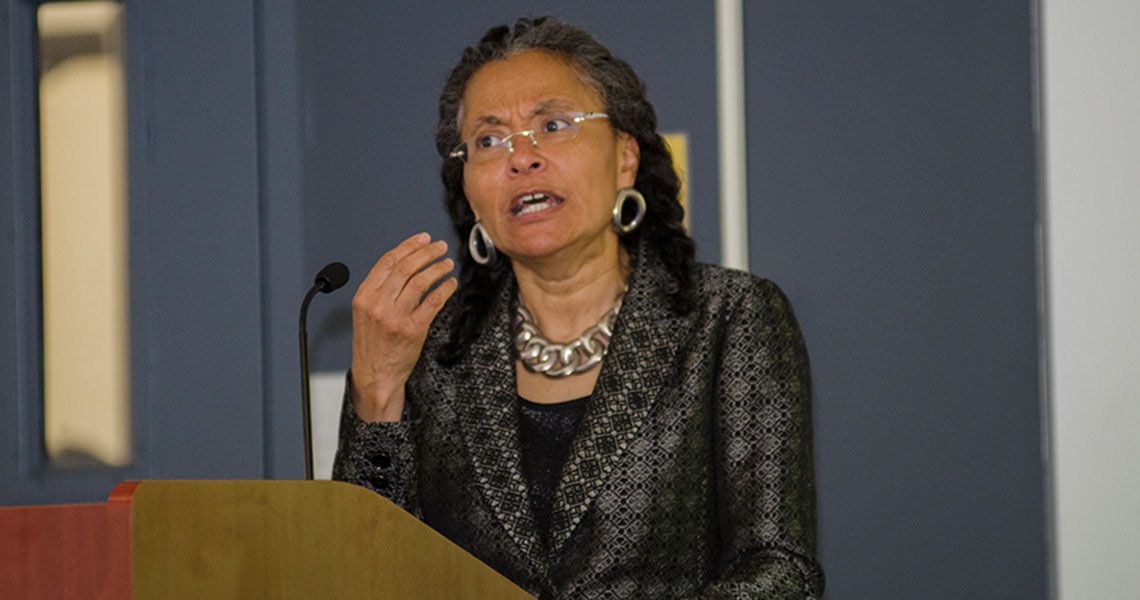There’s a saying that “knowledge equals power,” and when it comes to health equity, understanding how disparities in care arise goes a long way toward addressing them.
Camara Jones, M.D., Ph.D., M.P.H., the immediate past president of the American Public Health Association, spoke to George Washington University School (GW) School of Medicine and Health Sciences (SMHS) students and faculty about racism in health care and its impact on the wellness of the United States in a lecture titled “Achieving Health Equity: Tools for a National Campaign Against Racism.”
The lecture, held in GW’s Ross Hall on March 3, was sponsored by the SMHS Office of Diversity and Inclusion.
“We must talk about adjustments of social determinants of health,” said Jones, who serves as an adjunct associate professor of community health and preventive medicine at the Morehouse School of Medicine and the Rollins School of Public Health. “Adjusting poverty, adverse neighborhood conditions and the like, is important if we want to achieve large and sustained improvements in health outcomes. We don’t want everybody pushed up against the edge of the cliff.”
That cliff, Jones explained, is the “cliff of good health.” Imagine standing on the edge of the cliff and falling off of it. In some cases, the only means of rescue is an ambulance waiting at the bottom.
“What could we put in place as a health intervention besides an ambulance?” asked Jones. “Let’s put a net half way down. Even if people fall, we can catch them.”
However, the net, which represents safety-net programs like Medicaid, could have holes in it and some people may fall through the cracks, Jones noted. What about a trampoline? Well, she said, that could include interventions like screenings and early disease detection, but people may still be left without the resources to tackle the disease and get back to the top of the cliff. A fence might work, representing care including immunizations and public health awareness programs, to keep people from falling off, but that fence would have to be very strong.
So, what else is a good intervention? The answer, Jones said, is moving people away from the cliff’s edge.
In this metaphor, the ambulance serves as tertiary prevention, the net and trampoline as safety net programs and secondary prevention, the fence as primary prevention, and moving people away from cliff as addressing the social determinants of health.
“You can take this cliff to a community and start the discussion on how can we use our health resources, go to the state house, go to Congress with this diagram,” Jones said. However, there is one flaw with the tool, she added. “It does not equip us to talk about how health disparities arise.”
The cliff analogy, she said, needs to include a focus on interventions, such as safety net programs and primary care, but also must address health disparities, she added.
“When we’re talking about racial and ethnic disparities, which have a very long history in our nation, we unfortunately have a lot of evidence of differences in quality of care received within the health care system,” she said.
Health disparities happen due to differences in quality of care, differences in access to care, and differences in the conditions of our lives, Jones said.
“At some parts of the cliff, there might be an ambulance, but maybe that ambulance has a flat tire,” Jones explained. Or maybe there’s a net or fence, but the population is being pushed right up against them.
Doctors need to ask, she said, why are there differences in how resources are distributed along the cliff base? And, why are some populations pushed closer to edge?
“We must address the three-dimensionality of the cliff, must address social determinants of equity including racism, sexism, heterosexism, capitalism, and the like, if we want to achieve social justice and eliminate health disparities,” Jones said. “All of us must address inequity.”



